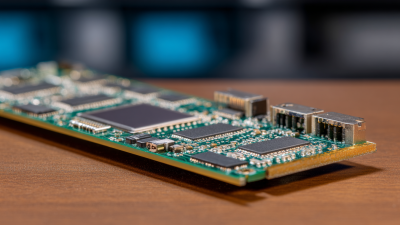Leave Your Message
In the rapidly evolving landscape of data networking, the emergence of 10 Gig SFP DWDM technology stands out as a transformative solution for enhancing bandwidth and connectivity. With the growing demand for higher data rates and more efficient networking solutions, organizations are increasingly turning to Dense Wavelength Division Multiplexing (DWDM) to meet these challenges.

This technology not only provides a scalable way to transmit multiple channels over a single optical fiber but also ensures that network infrastructure can support the increasing volume of data traffic. This article aims to delve into the intricacies of 10 Gig SFP DWDM technology, exploring its benefits, implementation strategies, and future implications.
By understanding this technology, network administrators and decision-makers can make informed choices that enhance their network's performance and reliability in an ever-connected world.
The rise of 10 Gig SFP DWDM (Dense Wavelength Division Multiplexing) technology marks a significant milestone in high-speed networking. As businesses continue to gravitate toward cloud services and data-intensive applications, the need for increased bandwidth has escalated. According to a recent industry report by ResearchAndMarkets, the global 10G SFP market is projected to grow at a CAGR of 10.5% by 2026, driven by the demand for efficient and high-capacity network solutions.
One of the main advantages of 10 Gig SFP DWDM technology is its ability to transmit data over long distances without the degradation typically associated with traditional copper cables. By utilizing multiple wavelengths to transmit data simultaneously through a single fiber, organizations can achieve remarkable data throughput. For instance, a single fiber can deliver up to 80 channels, each carrying 10 Gbps, enabling the support of massive network capacities with minimal physical infrastructure.
**Tips:** When considering an upgrade to 10 Gig SFP DWDM, evaluate your current network infrastructure and determine compatibility. Additionally, investing in robust monitoring tools can help you optimize traffic flow and address potential bottlenecks. Lastly, keep an eye on emerging technologies and standards, as the networking landscape is rapidly evolving, and early adoption can provide a significant competitive edge.
 The adoption of 10 Gig SFP DWDM (Dense Wavelength Division Multiplexing) technology offers significant advantages for enterprises looking to enhance their networking capabilities. One of the most appealing benefits is the ability to transmit multiple data streams over a single optical fiber, dramatically increasing bandwidth without requiring additional infrastructure. This efficient use of existing fiber resources can lead to substantial cost savings in both equipment and maintenance, allowing businesses to optimize their investment in network infrastructure.
The adoption of 10 Gig SFP DWDM (Dense Wavelength Division Multiplexing) technology offers significant advantages for enterprises looking to enhance their networking capabilities. One of the most appealing benefits is the ability to transmit multiple data streams over a single optical fiber, dramatically increasing bandwidth without requiring additional infrastructure. This efficient use of existing fiber resources can lead to substantial cost savings in both equipment and maintenance, allowing businesses to optimize their investment in network infrastructure.
Additionally, implementing 10 Gig SFP DWDM solutions contributes to improved network reliability and scalability. With the capability to manage multiple wavelengths, enterprises can easily expand their network as demand grows, accommodating increased data traffic seamlessly. Moreover, the resilience of DWDM technology provides better fault tolerance, ensuring minimal downtime and enhancing overall operational efficiency. As organizations continue to embrace digital transformation, 10 Gig SFP DWDM technology positions them to meet the evolving challenges of modern networking while maintaining a competitive edge in their respective markets.
 The global optical wavelength services market is on an upward trajectory, with projections indicating a growth from approximately $6.98 billion in 2025 to an impressive $17.65 billion by 2032. This significant expansion reflects a compound annual growth rate (CAGR) that showcases the increasing demand for advanced networking technologies such as 10 Gig SFP DWDM. As businesses and consumers continue to demand faster and more reliable data connections, the adoption of Dense Wavelength Division Multiplexing (DWDM) technology will become critical in supporting the bandwidth-intensive applications of the future.
The global optical wavelength services market is on an upward trajectory, with projections indicating a growth from approximately $6.98 billion in 2025 to an impressive $17.65 billion by 2032. This significant expansion reflects a compound annual growth rate (CAGR) that showcases the increasing demand for advanced networking technologies such as 10 Gig SFP DWDM. As businesses and consumers continue to demand faster and more reliable data connections, the adoption of Dense Wavelength Division Multiplexing (DWDM) technology will become critical in supporting the bandwidth-intensive applications of the future.
Tips for businesses considering the shift to 10 Gig DWDM include performing a thorough needs assessment to understand current and projected bandwidth requirements. Investing in scalable infrastructure will ensure that your network can grow alongside your business. Furthermore, collaborating with experienced technology providers can facilitate seamless integration and optimize performance.
In addition to optical wavelength services, related markets such as Fiber to the Home (FTTH) and data center interconnects are also set for robust growth. The FTTH market alone is expected to see its size rise to approximately $28.04 billion by 2025. Businesses should stay informed about these trends, as they will impact connectivity options and influence strategic planning in IT investments for years to come.
As the telecommunications landscape evolves, the importance of 10 Gig SFP DWDM technology becomes increasingly apparent. When compared to traditional networking solutions, 10 Gig SFP DWDM offers superior bandwidth capabilities, making it an ideal choice for handling the surging demand for data transmission. Reports indicate that the dark fiber market in Malaysia is projected to grow by USD 173.9 million from 2024 to 2028, primarily due to the exponential increase in global internet traffic driven by advancements in artificial intelligence. This growth underscores the necessity for high-capacity networking solutions like 10 Gig SFP DWDM that can efficiently support burgeoning data demands.
Additionally, traditional networking solutions often face limitations in scalability and performance, especially in high-traffic environments. In contrast, 10 Gig SFP DWDM technology utilizes wavelength division multiplexing to maximize fiber optics, allowing for multiple data streams to travel simultaneously over a single fiber strand. This not only optimizes infrastructure utilization but also significantly reduces latency, making it a powerful contender against legacy systems. As organizations seek to future-proof their networks, the adoption of 10 Gig SFP DWDM is poised to redefine connectivity standards in a data-centric world.
| Feature | 10 Gig SFP DWDM | Traditional Networking Solutions |
|---|---|---|
| Transmission Rate | 10 Gbps | 1 Gbps - 10 Gbps |
| Distance | Up to 80 km | Up to 1 km |
| Wavelengths | Multiple (from 1264.5 nm to 1337.5 nm) | Single wavelength |
| Cost | Higher upfront cost | Lower initial setup cost |
| Scalability | Highly scalable | Limited scalability |
| Latency | Lower latency | Higher latency |
| Installation | Requires careful installation | Easier installation |
| Networking Technology | Optical networking | Electrical networking |
Deploying 10 Gig SFP DWDM technology in modern data centers requires careful planning and execution to maximize performance and efficiency. One of the best practices is to conduct a thorough assessment of the existing infrastructure. Understanding the layout, current bandwidth usage, and future growth projections will help determine the right DWDM solutions and configurations. Additionally, selecting the appropriate optical fibers and transceivers is crucial; using single-mode fibers can significantly enhance the distance and reliability of transmissions, while ensuring that the transceivers are compatible with the data center’s equipment is key to a smooth deployment.
Another vital practice involves implementing robust monitoring and maintenance protocols. Continuous monitoring of network performance can help identify potential bottlenecks and optimize data flow. This can be achieved through deploying advanced network management tools that provide real-time analytics on traffic patterns and performance metrics. Regular maintenance and updates of the DWDM equipment will also play a significant role in sustaining optimal performance, ensuring that the infrastructure can adapt to changing demands and advances in technology. Investing in training for the technical staff regarding DWDM technology will further enhance the efficiency and reliability of the data center operations.
This chart illustrates the bandwidth capacity versus distance capabilities of 10 Gig SFP DWDM technology in modern data centers. As data traffic increases, understanding the performance improvements at various distances becomes crucial for effective deployment.






